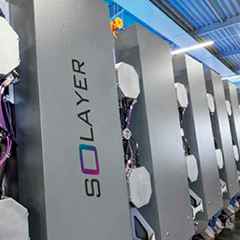A German equipment manufacturer of PVD (Physical Vapor Deposition) coating systems, Solayer GmbH is currently one of the industry’s hottest organisations, with a focus on innovation and customer service. In this technical dispatch, we take a look at what makes their solutions tick.
Solayer’s strengths lie in the development of novel functional optical layers for use in solar cells, displays and architectural glass and the design of key components, such as magnetrons, employed in physical vapor deposition processes. The company has recently expanded its product portfolio to include deposition systems for use in the production of flexible electronics and solar cells. Solayer has developed and built a vertical coater for the deposition of ZnO:Al in high volume manufacturing.
In the thin film solar industry, PVD and in particular sputtering, is a key step in the manufacturing process. The absorbing layers in the solar cell are surrounded by conducting layers that are responsible for directing the current out of the cell and to the contact strips of the module.
The thickness of the deposited contact layers as well as the electrical and optical properties of these layers need to be extremely uniform over the entire area of the glass substrate in order to minimise losses in the conversion of solar light to electricity.
In the case of low emissivity (low-E) glass coatings the challenge is to combine low-E materials, such as ZnO that are used to reduce the surface emissivity, with multi-layer stacks containing silver and other materials used for influencing the color of the coating. These layer stacks have been developed and refined over years and can contain 20 or more individual layers. Slight shifts in production conditions can change the layer uniformities and shift the desired optical functionality of the entire layer stack.
In an industrial setting, the specified functional layer properties, such as transparency and conductivity, need to be met while at the same time maintaining high system productivity and performance. The machine performance, and therefore total cost of ownership of the investment, depends on several operational factors.
In the case of large area glass coaters the key parameters are the cycle time, uptime and the material utilisation. The purchase of an industrial size glass coater is a major investment and manufacturers should strive to push machine productivity as high as possible. The maintenance should be able to be performed easily and rapidly, meaning that even unskilled personnel can be used. The shortened downtime combined with design for a high throughput translates to a high productivity, meaning that the key performance indicator, m2/year of coated glass, can be maximised.
Many of the materials used in metal and transparent oxide based contacts have a low abundance and can be very expensive. A target material is manufactured and examples for typical target materials include indium oxide, zinc oxide, and silver. Over the operational lifetime of the glass coater, the target costs can amount to over 50% of the total cost of ownership of the machine and process. Close cooperation between machine manufacturer and component supplier is therefore necessary to increase the utilisation of the materials used in the process.



























